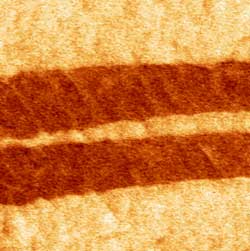ORNL microscopy yields first proof of ferroelectricity in simplest amino acid

ORNL researchers detected for the first time ferroelectric domains (seen as red stripes) in the simplest known amino acid – glycine.<br>
A multi-institutional research team led by Andrei Kholkin of the University of Aveiro, Portugal, used a combination of experiments and modeling to identify and explain the presence of ferroelectricity, a property where materials switch their polarization when an electric field is applied, in the simplest known amino acid—glycine.
“The discovery of ferroelectricity opens new pathways to novel classes of bioelectronic logic and memory devices, where polarization switching is used to record and retrieve information in the form of ferroelectric domains,” said coauthor and senior scientist at ORNL's Center for Nanophase Materials Sciences (CNMS) Sergei Kalinin.
Although certain biological molecules like glycine are known to be piezoelectric, a phenomenon in which materials respond to pressure by producing electricity, ferroelectricity is relatively rare in the realm of biology. Thus, scientists are still unclear about the potential applications of ferroelectric biomaterials.
“This research helps paves the way toward building memory devices made of molecules that already exist in our bodies,” Kholkin said.
For example, making use of the ability to switch polarization through tiny electric fields may help build nanorobots that can swim through human blood. Kalinin cautions that such nanotechnology is still a long way in the future.
“Clearly there is a very long road from studying electromechanical coupling on the molecular level to making a nanomotor that can flow through blood,” Kalinin said. “But unless you have a way to make this motor and study it, there will be no second and third steps. Our method can offer an option for quantitative and reproducible study of this electromechanical conversion.”
The study, published in Advanced Functional Materials, builds on previous research at ORNL's CNMS, where Kalinin and others are developing new tools such as the piezoresponse force microscopy used in the experimental study of glycine.
“It turns out that piezoresponse force microsopy is perfectly suited to observe the fine details in biological systems at the nanoscale,” Kalinin said. “With this type of microscopy, you gain the capability to study electromechanical motion on the level of a single molecule or small number of molecular assemblies. This scale is exactly where interesting things can happen.”
Kholkin's lab grew the crystalline samples of glycine that were studied by his team and by the ORNL microscopy group. In addition to the experimental measurements, the team's theorists verified the ferroelectricity with molecular dynamics simulations that explained the mechanisms behind the observed behavior.
Research team members are ORNL's Nina Balke, Stephen Jesse, Alexander Tselev, Pratul Agarwal and Bobby Sumpter; the University of Aveiro's Alejandro Heredia, Igor Bdikin and José Gracio; and Vincent Meunier of Rensselaer Polytechnic Institute. The full paper is published as “Nanoscale ferroelectricity in crystalline ? glycine” and is available here: http://onlinelibrary.wiley.com/doi/10.1002/adfm.201103011/full.
Part of this work was supported by the Center for Nanophase Materials Sciences (CNMS) at ORNL. CNMS is one of the five DOE Nanoscale Science Research Centers supported by the DOE Office of Science, premier national user facilities for interdisciplinary research at the nanoscale. Together the NSRCs comprise a suite of complementary facilities that provide researchers with state-of-the-art capabilities to fabricate, process, characterize and model nanoscale materials, and constitute the largest infrastructure investment of the National Nanotechnology Initiative. The NSRCs are located at DOE's Argonne, Brookhaven, Lawrence Berkeley, Oak Ridge and Sandia and Los Alamos national laboratories. For more information about the DOE NSRCs, please visit http://science.energy.gov/bes/suf/user-facilities/nanoscale-science-research-centers/.
The DOE's Division of Scientific User Facilities also supported the work. ORNL is managed by UT-Battelle for the Department of Energy's Office of Science. DOE's Office of Science is the single largest supporter of basic research in the physical sciences in the United States, and is working to address some of the most pressing challenges of our time. For more information, please visit http://science.energy.gov
Media Contact
More Information:
http://science.energy.govAll latest news from the category: Materials Sciences
Materials management deals with the research, development, manufacturing and processing of raw and industrial materials. Key aspects here are biological and medical issues, which play an increasingly important role in this field.
innovations-report offers in-depth articles related to the development and application of materials and the structure and properties of new materials.
Newest articles

Properties of new materials for microchips
… can now be measured well. Reseachers of Delft University of Technology demonstrated measuring performance properties of ultrathin silicon membranes. Making ever smaller and more powerful chips requires new ultrathin…

Floating solar’s potential
… to support sustainable development by addressing climate, water, and energy goals holistically. A new study published this week in Nature Energy raises the potential for floating solar photovoltaics (FPV)…

Skyrmions move at record speeds
… a step towards the computing of the future. An international research team led by scientists from the CNRS1 has discovered that the magnetic nanobubbles2 known as skyrmions can be…





















